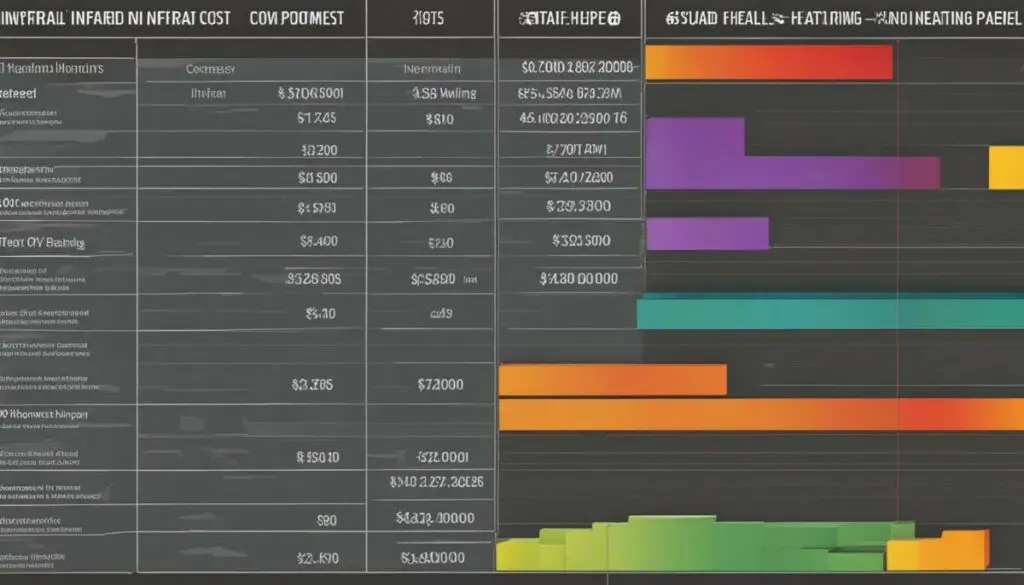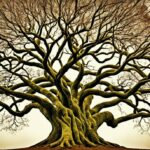Last Updated on 5 months by Francis
When it comes to keeping our little ones safe and comfortable, every parent wants to make the best choices. One consideration that often comes up is the safety of using infrared heaters in homes with babies. Are infrared heaters safe for babies? Let’s take a closer look at this topic and explore the safety considerations for using infrared heaters with babies.
Infrared heaters are a popular choice for heating family homes, and the good news is that they are safe and suitable for use even with young children. In fact, infrared heat is used in incubators to keep babies warm. These heaters provide 100% radiant warmth, which is a natural and safe form of heat. They emit a gentle warmth that is pleasant and comforting, creating a cozy environment for your little one.
Contents
Key Takeaways:
- Infrared heaters are safe for babies and provide a natural and gentle form of heat.
- They are often used in incubators to keep babies warm.
- Infrared heaters eliminate the risk of carbon monoxide leaks.
- They can be mounted high on walls or ceilings, keeping them out of reach of children.
- Some infrared heaters have additional safety features like shatter-proof glass.
The Safety Advantages of Infrared Panels

Infrared panels offer several safety features that make them an excellent choice for families with children. These panels are designed with child-friendliness in mind, ensuring a safe and comfortable heating solution for nurseries and family homes.
Safety Measures of Infrared Panels
1. Wall and Ceiling Mounting: Unlike traditional heaters, infrared panels can be mounted high on walls or ceilings, keeping them out of reach of children. This eliminates the risk of accidental contact and reduces the likelihood of burns or injuries.
2. Gentle Far Infrared Warmth: Infrared panels emit far infrared warmth, which mimics the natural heat produced by our bodies. This gentle warmth ensures that children are kept cozy and comfortable without the risk of overheating or hot surfaces.
3. No Carbon Monoxide Leaks: Unlike gas or oil heaters, infrared panels do not burn fuel to produce heat. This eliminates the risk of carbon monoxide leaks, which can be extremely dangerous, especially for young children.
Additionally, infrared panels do not heat the surrounding air, preventing the circulation of dust and allergens that could potentially aggravate allergies. They can also be paired with external controllers, allowing parents to easily control the temperature and ensure that it remains at a safe level for children. Furthermore, glass infrared heaters are shatter-proof, minimizing the risk of injury in case of accidents.
| Safety Features | Description |
|---|---|
| Wall and Ceiling Mounting | Keeps panels out of reach of children, reducing the risk of accidental contact and burns. |
| Gentle Far Infrared Warmth | Mimics natural body heat, providing a comfortable and safe warmth for children. |
| No Carbon Monoxide Leaks | Eliminates the risk of carbon monoxide poisoning, ensuring a safe environment for children. |
| Allergy-Proof | Does not heat the surrounding air, preventing the circulation of dust and allergens that could aggravate allergies. |
| External Controllers | Allows parents to easily control the temperature and keep it at a safe level for children. |
| Shatter-Proof | Glass infrared heaters are designed to be shatter-proof, minimizing the risk of injury in case of accidents. |
With these safety advantages, infrared panels provide parents with peace of mind, knowing that they have chosen a child-friendly heating solution that prioritizes the safety and well-being of their little ones.
Top Child-Friendly Features of Infrared Panels
Infrared panels offer a range of child-friendly features, making them an ideal choice for nurseries and ensuring safe heating options for infants. These features are designed to prioritize the safety and well-being of children while providing efficient and effective heating solutions. Let’s explore some of the top child-friendly features of infrared panels:
Infrared Panels for Nurseries
When it comes to nursery settings, safety is paramount. Infrared panels are an excellent heating solution as they are mounted high on walls or ceilings, keeping them out of the reach of curious little hands. This eliminates the risk of accidental contact and ensures a safe environment for infants and toddlers. The elevated positioning of the panels also ensures even distribution of gentle warmth throughout the room, creating a cozy and comfortable space for children.
Temperature Detection Mechanism
Many infrared panels come equipped with a temperature detection mechanism that automatically shuts off the heater if the temperature exceeds recommended limits. This feature provides an added layer of safety, preventing the risk of fire or overheating. Parents can have peace of mind knowing that the infrared panels are constantly monitoring the temperature and taking necessary precautions to ensure the safety of their children.
Remote Temperature Monitoring and Control
Some infrared panels can be controlled through smartphone apps, allowing parents to remotely monitor and adjust the temperature in their child’s room. This feature is especially convenient for busy parents who want to ensure their little ones are cozy and comfortable without having to physically be in the room. By simply accessing the app, parents can adjust the temperature to create the perfect environment for their child’s needs.
With these child-friendly features, infrared panels offer a safe and reliable heating solution for nurseries and family homes. The combination of elevated positioning, temperature detection mechanisms, and remote control capabilities prioritizes child safety while providing efficient warmth. Parents can rest assured knowing that their little ones are comfortable and protected in a space heated by child-safe infrared panels.
Understanding Infrared Heating Panels

Infrared heating panels are a popular choice for efficient and comfortable heating. But what exactly are they, and how do they work? Let’s dive into the details.
What are Infrared Heating Panels?
Infrared heating panels are electric heaters that emit radiant heat instead of heating the air. They work by emitting infrared radiation, which travels through the air and is absorbed by objects in the room, including people. This direct heat transfer creates a comfortable and even distribution of heat, making it an excellent choice for heating homes.
How Do Infrared Heating Panels Work?
Infrared heating panels generate heat through a process called Far Infrared Radiation (FIR). When electricity passes through the heating elements of the panel, it emits FIR energy, which warms up the objects and individuals present in the room. Since infrared heat does not rely on heating the surrounding air, it provides quick and efficient warmth without causing any drafts or dust circulation.
Benefits of Infrared Heating Panels
There are several benefits to choosing infrared heating panels for your home. Firstly, they provide instant and direct heat, allowing you to feel warm in a matter of minutes. Secondly, infrared panels are energy-efficient, as they only heat the objects in the room and do not waste energy on heating the air. This can result in cost savings on your energy bills. Additionally, infrared heating is a healthy option, as it does not dry out the air or create air currents that can spread allergens. Lastly, infrared panels are easy to install and can be integrated into various designs, allowing you to incorporate them seamlessly into your home decor.
| Benefits of Infrared Heating Panels | Why Choose Infrared Heating Panels |
|---|---|
| Instant and direct heat | Energy-efficient and cost-saving |
| Healthy heating option | Easy to install and integrate into home decor |
“Infrared heating panels provide efficient and comfortable warmth by emitting radiant heat. They are an energy-efficient and healthy heating option for any home.” – HVAC expert
The Cost of Infrared Heating Panels

Infrared heating panels offer a cost-effective solution for heating your home. The price of an infrared heating panel can vary depending on factors such as design, radiant power, and quality. On average, the price of an infrared heating panel is around £495. However, it’s important to consider the long-term savings these panels can provide. Infrared heating panels can help reduce heating costs by 30-50%, which can lead to significant savings over time.
To give you an idea of the total cost, heating a four-bedroom house with infrared panels would amount to approximately £6,000. While this initial investment may seem higher compared to other heating systems, it’s important to consider the long-term benefits. Infrared heating panels have lower maintenance requirements and can be easily installed, making them a cost-effective choice in the long run.
Factors Affecting the Cost
The cost of infrared heating panels can be influenced by several factors:
- Design: The design of the panel, whether it’s integrated into a mirror or mounted on a wall or ceiling, can impact the price.
- Radiant Power: Higher radiant power panels may cost more.
- Quality: Panels of higher quality materials and construction may come with a higher price tag.
It’s important to consider these factors when choosing an infrared heating panel that fits your budget and heating needs.
| Factors | Price Range |
|---|---|
| Design | £300 – £800 |
| Radiant Power | £400 – £1,000 |
| Quality | £400 – £1,200 |
As you can see, there’s a wide range of prices available depending on your preferences and requirements. It’s important to find the right balance between cost and features to ensure you’re getting the best value for your investment.
Different Types of Infrared Heating Panels

When it comes to infrared heating panels, there are various types available to suit different indoor and outdoor heating needs. These panels offer flexibility and versatility with their unique designs and functionality.
Infrared Panels for Indoor Use
Indoor infrared panels are designed to provide efficient and effective heating solutions for residential and commercial spaces. They can be integrated into accessories such as mirrors, making them a stylish and space-saving option. These panels emit far-infrared heat, which closely resembles natural body heat and creates a comfortable and cozy environment.
Infrared Panels for Outdoor Use
For outdoor heating needs, there are infrared panels specifically designed to withstand harsh weather conditions. These panels, known as quartz heaters, can reach much higher temperatures than indoor panels and emit near-infrared heat. They are often used in outdoor patios, gardens, or other open spaces where direct heat is required.
| Type of Infrared Panel | Usage | Temperature Range | Heat Emission |
|---|---|---|---|
| Indoor Panels | Residential and commercial spaces | Up to 90˚C | Far-infrared heat |
| Outdoor Panels (Quartz Heaters) | Patios, gardens, open spaces | Up to 1500˚C | Near-infrared heat |
Additionally, there are specialized infrared panels designed for specific needs. For example, there are pet heaters available for kennels and catteries, ensuring warmth and comfort for furry friends even in colder climates. Under-desk panels are also available for workspaces, providing localized heating options for individual comfort.
With the wide range of options available, individuals can choose the most suitable infrared heating panels based on their specific requirements and preferences. Whether it’s for indoor or outdoor use, these panels offer an efficient and effective heating solution with customizable designs and features.
Advantages and Disadvantages of Infrared Heating Panels

When considering the use of infrared heating panels, it’s important to weigh the pros and cons to make an informed decision. Here are the advantages and disadvantages of using these panels for heating your home:
Advantages of Infrared Heating Panels
- Efficient Heating: Infrared panels emit radiant heat that directly warms objects and people in the room, resulting in quick and comfortable heating.
- Space-Saving Design: With their slim profile and wall or ceiling mounting options, infrared panels take up minimal space and can be discreetly integrated into your home’s decor.
- Even Heat Distribution: Unlike traditional heaters, infrared panels distribute heat evenly across the room, eliminating cold spots and providing consistent warmth.
- No Air Circulation: Infrared panels do not rely on heating the air, which means they don’t circulate dust or allergens, making them a great choice for people with respiratory conditions or allergies.
- Low Maintenance: These panels have few moving parts and require minimal maintenance, saving you time and money on repairs.
Disadvantages of Infrared Heating Panels
- Higher Operating Costs: Compared to other heating systems, such as gas or oil, the cost per unit of energy for electricity is higher, resulting in potentially higher monthly heating bills.
- Dependence on Electricity: Infrared panels rely on electricity as their power source, so power outages can temporarily leave you without heat.
- Potential for Electromagnetic Sensitivity: Some individuals with electromagnetic sensitivity may experience discomfort or adverse effects from certain types of infrared heaters.
Overall, infrared heating panels offer numerous advantages such as efficient heating, space-saving design, and even heat distribution. However, it’s important to consider the higher operating costs and the potential for electromagnetic sensitivity when deciding if infrared heating panels are the right choice for your home.
| Advantages | Disadvantages |
|---|---|
| Efficient heating | Higher operating costs |
| Space-saving design | Dependence on electricity |
| Even heat distribution | Potential for electromagnetic sensitivity |
| No air circulation | |
| Low maintenance |
The Environmental Impact of Infrared Heating Panels

When considering heating options for your home, it’s important to also consider the environmental impact of your choice. Infrared heating panels are a sustainable and eco-friendly option that offer several advantages in terms of energy efficiency and carbon footprint.
One of the key benefits of infrared heating panels is their energy efficiency. These panels have higher efficiency ratings compared to traditional electric and gas boilers, with some reaching ratings of 112-115%. This higher efficiency means reduced energy consumption and lower heating costs, making them a greener choice for your home.
In terms of carbon footprint, infrared heating panels produce very low emissions. They don’t burn fossil fuels and don’t require a dedicated flue or chimney. However, it’s crucial to consider the source of electricity used to power the panels. To ensure true eco-friendliness, it’s recommended to power your infrared heating panels with electricity from renewable sources.
The Environmental Benefits:
- High energy efficiency, reducing energy consumption and costs
- Low carbon footprint due to low emissions
- Don’t burn fossil fuels and don’t require a dedicated flue or chimney
By choosing infrared heating panels and powering them with renewable energy, you can enjoy the benefits of a comfortable and efficient heating system while minimizing your impact on the environment. It’s a small step towards creating a more sustainable and eco-friendly home.
Infrared Panels and Water Heating
While infrared panels are primarily designed for heating indoor spaces, they can be integrated with water heating systems to provide hot water in addition to space heating. This versatility makes infrared panels a convenient option for households that require both types of heating.
Integrating infrared panels with water heating systems allows for a combined heating solution that caters to both space heating and water heating needs. By coupling infrared panels with a traditional electric immersion heater or water cylinder, households can enjoy the benefits of both efficient space heating and readily available hot water.
It is important to note that while infrared panels can contribute to water heating, their main function remains focused on providing radiant warmth to indoor spaces. Therefore, they may not be the most efficient or practical solution for large-scale water heating needs.
Overall, integrating infrared panels with water heating systems offers a convenient and energy-efficient solution for households looking to optimize their heating capabilities. With the ability to provide both space heating and hot water, infrared panels offer a versatile option for enhancing comfort and functionality in the home.
Benefits of Integrating Infrared Panels with Water Heating Systems:
- Combined space heating and water heating solution
- Energy-efficient and cost-effective
- Convenient and versatile
- Enhanced comfort and functionality in the home
Conclusion
In conclusion, infrared heaters are a fantastic choice for families with babies and young children. They provide safe and natural radiant warmth, which is similar to the heat used in incubators to keep newborns warm. With features such as high wall or ceiling mounting, gentle warmth, and no risk of carbon monoxide leaks, infrared panels offer peace of mind when it comes to the safety of your little ones.
Not only are infrared heaters safe, but they also come with child-friendly features. Some panels have temperature detection mechanisms that prevent overheating and the risk of fire. Others are equipped with fire-resistant coatings, reducing the chance of accidents. Additionally, infrared panels can be controlled through smartphone apps, allowing parents to monitor and adjust the temperature remotely.
Overall, infrared heating panels provide a reliable, cost-effective, and energy-efficient heating solution for nurseries and family homes. Their minimal space requirements, even heat distribution, and low maintenance needs make them an excellent choice. So, if you’re looking for a child-friendly heating option that offers warmth and peace of mind, infrared heaters are the way to go.
FAQ
Are infrared heaters safe for babies?
Yes, infrared heaters are safe for babies. They provide 100% radiant warmth, which is a natural and safe form of heat. Infrared heat is used in incubators to keep babies warm.
What safety features do infrared panels have?
Infrared panels have several safety features that make them child-friendly. They can be mounted high on walls or ceilings, provide gentle warmth, and eliminate the risk of carbon monoxide leaks. They are also allergy-proof and can be paired with external controllers to keep controls out of reach of children. Glass infrared heaters are shatter-proof, reducing the risk of injury.
What are the top child-friendly features of infrared panels?
Infrared panels have three standout child-friendly features. Firstly, they have a temperature detection mechanism that shuts off the heater if it exceeds recommended limits. Secondly, certain panels have a fire-resistant coating for added safety. Lastly, some panels can be controlled through a smartphone app, allowing parents to remotely monitor and adjust the temperature in their child’s room.
How do infrared heating panels work?
Infrared heating panels emit radiant heat instead of heating the air. They emit infrared radiation, which is absorbed by objects in the room, including people. This direct heat transfer creates a comfortable and even distribution of heat.
What is the cost of infrared heating panels?
The cost of infrared heating panels varies depending on factors such as design, radiant power, and quality. On average, an infrared heating panel can cost around £495. To heat a four-bedroom house with infrared panels, the total cost would be around £6,000. However, infrared panels can help reduce heating costs by 30-50%.
What are the different types of infrared heating panels?
There are various types of infrared heating panels available. They can be integrated into mirrors or other accessories, mounted on walls or ceilings, and some are specifically designed for outdoor use. Quartz heaters are suitable for outdoor use, while far-infrared panels are best for indoor locations.
What are the advantages and disadvantages of infrared heating panels?
Infrared heating panels have advantages such as their variety of designs, minimum space requirements, and even heating of surfaces. However, they have higher operating costs compared to other heating systems and may not be climate neutral unless powered by renewable electricity. Some individuals with electromagnetic sensitivity may also experience discomfort from certain types of infrared heaters.
Are infrared heating panels eco-friendly?
Yes, infrared heating panels are considered eco-friendly due to their energy efficiency and low carbon footprint. They have higher efficiency ratings compared to electric and gas boilers, resulting in reduced energy consumption and lower heating costs. However, the source of electricity used to power the panels should be considered for them to be truly climate neutral.
Can infrared panels heat water?
Infrared panels are primarily designed for heating indoor spaces and do not directly heat water. However, they can be coupled with a traditional electric immersion heater or water cylinder to provide hot water in addition to space heating.
What is the conclusion on infrared heaters for babies?
Infrared heaters are a safe and child-friendly heating option for families with babies and young children. They provide natural and safe radiant warmth, have additional safety features, and can be integrated into various designs. Infrared heating panels offer a reliable and safe heating solution for nurseries and family homes.





.jpg)



